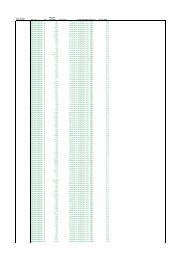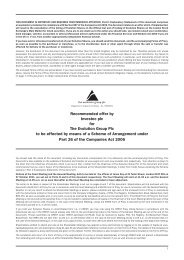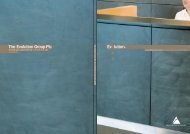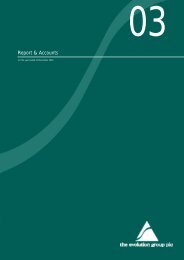Annual Report for the year ended 31 December 2008
Annual Report for the year ended 31 December 2008
Annual Report for the year ended 31 December 2008
Create successful ePaper yourself
Turn your PDF publications into a flip-book with our unique Google optimized e-Paper software.
) Distribution channels and customer relationships: purchased distribution<br />
channels and customer relationships are capitalised at cost less<br />
amortisation and provisions <strong>for</strong> impairment over <strong>the</strong>ir estimated useful lives.<br />
c) Computer software: Acquired computer software licenses are stated at<br />
cost, including those costs incurred to acquire and bring to use <strong>the</strong> specific<br />
software, less amortisation and provisions <strong>for</strong> impairment, if any.<br />
Any intangible assets with a finite life are amortised over a period of <strong>the</strong>ir<br />
useful lives on a straight-line basis.<br />
The following useful lives have been determined <strong>for</strong> intangible assets:<br />
computer software 3 <strong>year</strong>s<br />
customer relations 5 <strong>year</strong>s<br />
Brand 5 <strong>year</strong>s<br />
Distribution channels 5 <strong>year</strong>s<br />
Intangible assets with an indefinite useful life<br />
Financial Industry Regulatory Authority (“FINRA”) Licence<br />
costs associated with <strong>the</strong> acquisition of <strong>the</strong> us Broker Dealer, esus, are deemed<br />
to relate to <strong>the</strong> FinrA licence only. The licence is deemed to have an indefinite<br />
life, based on continuing FinrA membership having no fixed life, and consequently<br />
is not being amortised.<br />
Financial Services Authority (“FSA”) Regulatory Status<br />
costs associated with <strong>the</strong> acquisition of WDB capital limited (previously<br />
Wickam capital limited on 14 August 2007), are deemed to relate to its<br />
FsA regulatory status. The regulatory status is deemed to have an indefinite<br />
life, based on continuing FsA membership having no fixed life, and<br />
consequently is not being amortised.<br />
Property, plant and equipment<br />
All property, plant and equipment (“ppe”) is shown at cost less subsequent<br />
depreciation and impairment. cost includes expenditure that is directly<br />
attributable to <strong>the</strong> acquisition of <strong>the</strong> item. Depreciation on ppe is calculated<br />
using <strong>the</strong> straight-line method to allocate <strong>the</strong> cost of each asset to its<br />
residual value over its estimated useful life, as follows:<br />
leasehold improvements over 5 <strong>year</strong>s<br />
computers and similar equipment over 3 to 5 <strong>year</strong>s<br />
Fixtures, fittings, and o<strong>the</strong>r equipment over 3 to 5 <strong>year</strong>s<br />
Major renovations are depreciated over <strong>the</strong> remaining useful life of <strong>the</strong><br />
related asset or to <strong>the</strong> date of <strong>the</strong> next major renovation, whichever is sooner.<br />
Impairment of goodwill, intangible assets and PPE<br />
Goodwill and intangible assets that have an indefinite useful life are<br />
not subject to amortisation or depreciation and are tested annually <strong>for</strong><br />
impairment. o<strong>the</strong>r intangibles and ppe are assessed at <strong>the</strong> reporting date<br />
or whenever events or changes in circumstance indicate that <strong>the</strong> carrying<br />
amount may not be recoverable. The impairment review comprises a<br />
comparison of <strong>the</strong> carrying amount of <strong>the</strong> asset with its recoverable amount<br />
of <strong>the</strong> asset or cash generating unit (<strong>for</strong> goodwill and intangible assets with<br />
an indefinite useful life).<br />
notes to tHe FinanCial statements CONTINuED<br />
FOR THE YEAR ENDED <strong>31</strong> DECEMBER <strong>2008</strong><br />
The recoverable amount is <strong>the</strong> higher of an asset’s or cash generating units<br />
fair value less costs to sell and its value in use. An impairment loss is<br />
recognised in <strong>the</strong> consolidated income statement in <strong>the</strong> period in which it<br />
occurs <strong>for</strong> <strong>the</strong> amount by which <strong>the</strong> asset’s or cash generating unit’s carrying<br />
amount exceeds its recoverable amount.<br />
The assets’ residual values and useful lives, are reviewed and adjusted if<br />
necessary at each Balance sheet date.<br />
Financial assets and liabilities<br />
The Group classifies its financial assets and liabilities as trading portfolio<br />
assets and liabilities, available-<strong>for</strong>-sale financial assets, derivative financial<br />
instruments, stock borrowing and lending, trade and o<strong>the</strong>r receivables, cash<br />
and cash equivalents, and trade and o<strong>the</strong>r payables. The classification<br />
depends on <strong>the</strong> purpose <strong>for</strong> which <strong>the</strong> assets and liabilities were acquired.<br />
Management determines <strong>the</strong> classification of its investments at initial<br />
recognition and re-evaluates this designation at every reporting date.<br />
Financial assets are initially recognised at fair value plus transaction costs<br />
<strong>for</strong> all financial assets not carried at fair value through <strong>the</strong> profit or loss.<br />
Financial assets carried at fair value through profit or loss are initially<br />
recognised at fair value, and transaction costs are expensed in <strong>the</strong> income<br />
statement. Financial assets are derecognised when <strong>the</strong> rights to receive<br />
cash flows from <strong>the</strong> financial assets have expired or where <strong>the</strong> company<br />
has transferred substantially all risks and rewards of ownership. Financial<br />
liabilities are derecognised when <strong>the</strong>y are extinguished, that is, when <strong>the</strong><br />
obligation is discharged, cancelled or expires.<br />
Trading portfolio assets and liabilities<br />
Financial assets and liabilities are classified as held <strong>for</strong> trading if acquired<br />
principally <strong>for</strong> <strong>the</strong> purpose of selling in <strong>the</strong> short-term or if so designated by<br />
management. purchases and sales of investments are recognised on trade date,<br />
being <strong>the</strong> date on which <strong>the</strong> company commits to purchase or sell <strong>the</strong> asset.<br />
Available-<strong>for</strong>-sale financial assets<br />
Available-<strong>for</strong>-sale financial assets are ei<strong>the</strong>r designated in this category or<br />
are not classified in any o<strong>the</strong>r category. Available-<strong>for</strong>-sale financial assets<br />
are those int<strong>ended</strong> to be held <strong>for</strong> an indefinite period of time, which may be<br />
sold in response to needs <strong>for</strong> liquidity or changes in interest rates, exchange<br />
rates or equity prices. They are initially recognised at fair value including<br />
direct and incremental transaction costs. They are subsequently held at fair<br />
value. Dividends on available-<strong>for</strong>-sale equity instruments are recognised in<br />
<strong>the</strong> income statement when <strong>the</strong> entity’s right to receive payment is established.<br />
Gains and losses arising from changes in fair value are included as a separate<br />
component of equity within fair value and o<strong>the</strong>r reserves until sale or when impaired,<br />
when <strong>the</strong> cumulative gain or loss is transferred to <strong>the</strong> income statement.<br />
Measurement of trading portfolio assets and liabilities and available-<strong>for</strong>sale<br />
financial assets<br />
For trading portfolio assets and liabilities and available-<strong>for</strong>-sale financial assets<br />
that are quoted in active markets, fair values are determined by reference to<br />
<strong>the</strong> current quoted bid/offer price, with trading portfolio assets marked to <strong>the</strong><br />
bid price and trading portfolio liabilities marked at <strong>the</strong> offer price. Where<br />
independent prices are not available, fair values may be determined using<br />
valuation techniques with reference to observable market data.<br />
47







![2. Front continued [c87307] - The Evolution Group PLC](https://img.yumpu.com/19604468/1/184x260/2-front-continued-c87307-the-evolution-group-plc.jpg?quality=85)

